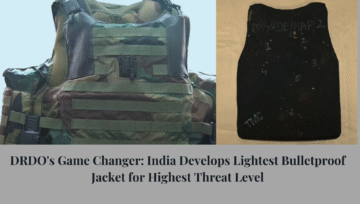DRDO Develops India’s Lightest Bulletproof Jacket for Highest Threat Level
The Defence Research and Development Organisation (DRDO) has achieved a significant milestone in developing protective gear for Indian soldiers. Indian scientists at the Defence Materials and Stores Research and Development Establishment (DMSRDE) in Kanpur have developed the country’s lightest bulletproof jacket, offering the highest level of protection (Level 6) as defined by the Bureau of Indian Standards (BIS) 17051-2018.
Enhanced Soldier Protection
This new bulletproof jacket offers superior protection against powerful ammunition, including 7.62×54 R API rounds typically fired from sniper rifles. The jacket’s design prioritizes soldier safety during combat situations by effectively stopping these high-velocity bullets.
Key Features of the New Jacket
- Level 6 Protection: The jacket surpasses previous models by achieving Level 6 certification, the highest level of ballistic protection offered by bulletproof vests in India.
- Lightweight Design: One of the most impressive aspects of this new jacket is its weight. At only 9.5 kg, it is significantly lighter than previous models, enhancing soldier mobility and comfort during operations.
- Ergonomic Design: The front Hard Armour Panel (HAP) is ergonomically designed to provide maximum protection while conforming to the wearer’s body. This design element ensures comfort and freedom of movement during combat.
- Monolithic Ceramic Plate: The HAP utilizes a monolithic ceramic plate backed by polymer material. This combination offers excellent ballistic protection while keeping the weight manageable.
- Multiple Hit Resistance: The front HAP is designed to withstand multiple hits, up to six shots of 7.62×54 R API rounds, fired from sniper rifles in both standalone and in-conjunction-with (ICW) configurations.
- Rigorous Testing: The jacket has undergone rigorous testing at the Terminal Ballistic Research Laboratory (TBRL) in Chandigarh to ensure it meets the BIS standards for Level 6 protection.
Significance of this Development
The development of this lightweight, high-protection bulletproof jacket is a major achievement for DRDO. It equips Indian soldiers with enhanced protection on the battlefield, potentially saving lives during combat. The lighter weight of the jacket also translates to improved soldier mobility and agility, crucial factors in the success of military operations.
Mission of DMSRDE
The Defence Materials and Stores Research and Development Establishment (DMSRDE) plays a vital role in developing protective gear and other critical equipment for the Indian military. Their mission includes:
- Research and development of materials specifically designed for the Indian Armed Forces.
- Designing, developing, and evaluating advanced materials for various defense applications, including protective clothing and equipment.
- Establishing itself as a globally recognized center of excellence in strategic non-metallic and specialty materials, promoting Indian self-reliance in defense technology.
Looking Ahead
DRDO’s accomplishment in creating this cutting-edge bulletproof jacket highlights India’s ongoing commitment to developing indigenous defense technologies. This innovation equips Indian soldiers with superior protection and ensures they are well-equipped to handle the evolving threats of the modern battlefield.
Unlock the Secrets of Current Affairs:
1. What is the significance of DRDO’s development of a new bulletproof jacket?
This jacket offers the highest level of ballistic protection currently available in India (Level 6) and is the lightest ever developed by DRDO. This translates to better soldier safety and improved mobility during combat operations.
2. What ammunition can this jacket withstand?
The jacket is designed to effectively stop powerful rounds like 7.62×54 R API ammunition typically fired from sniper rifles.
3. What is the weight of this new jacket?
This jacket weighs only 9.5 kg, making it a significant improvement over previous models that were heavier and potentially restricted soldier movement.
4. What is the technology behind the jacket’s effectiveness?
The front Hard Armour Panel (HAP) utilizes a monolithic ceramic plate backed by polymer material. This combination offers excellent ballistic protection while keeping the weight manageable.
5. How has the jacket been tested?
The jacket has undergone rigorous testing at the Terminal Ballistic Research Laboratory (TBRL) in Chandigarh to ensure it meets the Bureau of Indian Standards (BIS) Level 6 ballistic protection standards.
6. What are some of the benefits of a lighter bulletproof jacket for soldiers?
Reduced weight translates to improved soldier mobility, agility, and stamina during combat operations. This can be crucial for successful mission execution and soldier safety.
7. Who developed this new bulletproof jacket?
A team of scientists at the Defence Materials and Stores Research and Development Establishment (DMSRDE) in Kanpur, a unit of DRDO, is credited with this development.
8. How does this jacket compare to existing models used by the Indian Army?
This new jacket offers superior protection (Level 6) compared to some existing models and is significantly lighter, enhancing soldier comfort and maneuverability.
9. Will this jacket be readily available for deployment by Indian soldiers?
The official announcement did not specify the timeline for deployment. However, successful testing suggests it could be integrated into soldier equipment after necessary approvals.
10. What are some other features of this new jacket?
The ergonomically designed front HAP ensures a comfortable fit while maximizing protection. The jacket is also designed to withstand multiple hits.
11. What is the role of DMSRDE in Indian defense?
DMSRDE plays a vital role in developing protective gear and other critical equipment for the Indian military. Their mission includes research and development of materials specifically designed for the Indian Armed Forces.
12. What are some of the broader implications of this development?
This achievement showcases India’s growing self-reliance in defense technology. It equips soldiers with enhanced protection and potentially positions India as a potential exporter of such advanced bulletproof jackets.
13. Are there any limitations to this new jacket?
While details are limited, there might be trade-offs between weight, mobility, and protection level offered by different components of the jacket.
14. How does this new jacket compare to bulletproof vests used by other countries?
Comparisons are difficult without specific details on materials and protection levels of jackets used by other nations. However, India’s achievement signifies its place among countries developing advanced military equipment.
15. What are some future directions for bulletproof jacket development?
Future advancements might focus on even lighter materials while maintaining or improving protection levels. Additionally, research on smart materials with self-repairing capabilities or integrated sensors could be explored
OTHER LINKS:
India’s Landmark Defence Export: BrahMos Missile Systems to Reach Philippines in next 10 days





